Category:Multi-Language Font
2020/09/14
DynaFont for Other Languages—DynaFont King Gothic (Tamil)

Yellow, orange, red, brown...spices in all colors,
this allure of which no taste buds can resist.
No sequence or order exists in this landscape of unique, varying colors.
With yellows as dazzling as gold and red as fiery as flames of passion,
a mesmerizing charm is released powerfully in this noisy environment!
Located in the tropical zone of South Asia, India is most famous for its spices. Indian cuisine is seasoned with numerous spices and mixed into various sauces, taking travelers on an adventure of the senses. Locals refer to mixed spices as masala, and the vitality of this land is similar – as it integrates drastically different races, languages, and religions, all of which come together to engender the mystique and intrigue that India holds.
There is more than one India!

While curries, Bollywood, and mysterious gods offer a lasting impression of India, we are often still surprised by the diversity and complexity of this land when looking deeper into its culture. Traveling in India means constantly breaking stereotypes - throughout travels spanning hundreds of miles, you will be exposed to very different languages and customs.
India has wide-raging cultural traits, and substantial differences indeed exist across different geographical regions. Language is one of the most direct ways to understand the complicated make-up of this continent. There are as many as 22 official languages in each state and, if all dialects are included, more than 1,600 language variations are spoken across India - such surprising diversity! Besides the most prevalent spoken languages - Hindi and English - Indian paper bills are also printed with 15 of the country's other main languages.
There is no single dominant language within India. Even Hindi, the official language used by most people, is still only the first language of less than 40% of the population. In government institutions or schools, often times many languages are simultaneously used, or English is simply used for communication. An international brand of carbonated drinks even found different endorsers for its advertisements in south and north India, then released versions accordingly in different languages.
An ancient language with a long history—Tamil
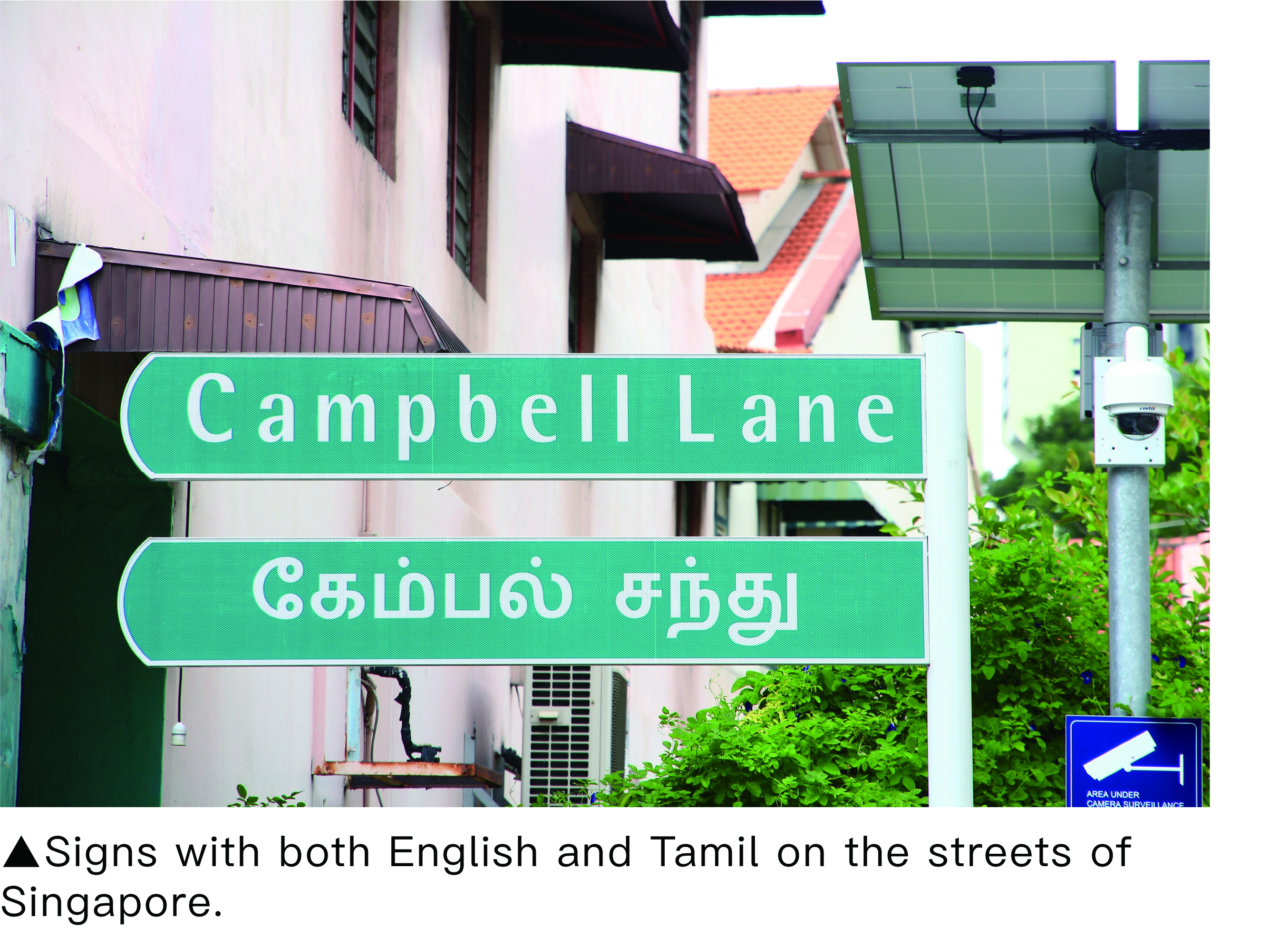 Hindi is the main language in northern India, while states in the south communicate in official local languages. Among these are quite a few languages that have persisted over thousands of years of history and survived with the ancient culture of India. In 2004, the Indian government officially set up a category of classical languages, giving this title to languages with particularly long and enduring histories. The first language recognized was one spoken and used in the south: Tamil
Hindi is the main language in northern India, while states in the south communicate in official local languages. Among these are quite a few languages that have persisted over thousands of years of history and survived with the ancient culture of India. In 2004, the Indian government officially set up a category of classical languages, giving this title to languages with particularly long and enduring histories. The first language recognized was one spoken and used in the south: TamilTamil has a history of more than 2,000 years. Experts believe that it developed from Brahmic scripts, as with other Indian characters. It can be traced back to the Ashoka period (approximately 304-232 BC) of ancient India and has a deep literary tradition. Unlike ancient Sanskrit or Latin, which are now only known by a handful of scholars, the Tamil language continues to be used in the daily life of people living in south India and northeast Sri Lanka.
Because Tamil people were extraordinary in disciplines like medicine and architecture, the language was also passed down through texts on subjects in related fields. This region is in direct proximity with the Indian Ocean and the Bay of Bengal, a geographical advantage that has enabled locals to develop sea navigation skills and a taste for ocean journeys. The local people have migrated to other places, bringing the language with them to other corners of the world. Tamil is now spoken in more than 30 countries - and is even one of Singapore's official languages! One linguist described Tamil as the “language of the world."
Tropical palm leaves influenced the curvy design of Tamil characters
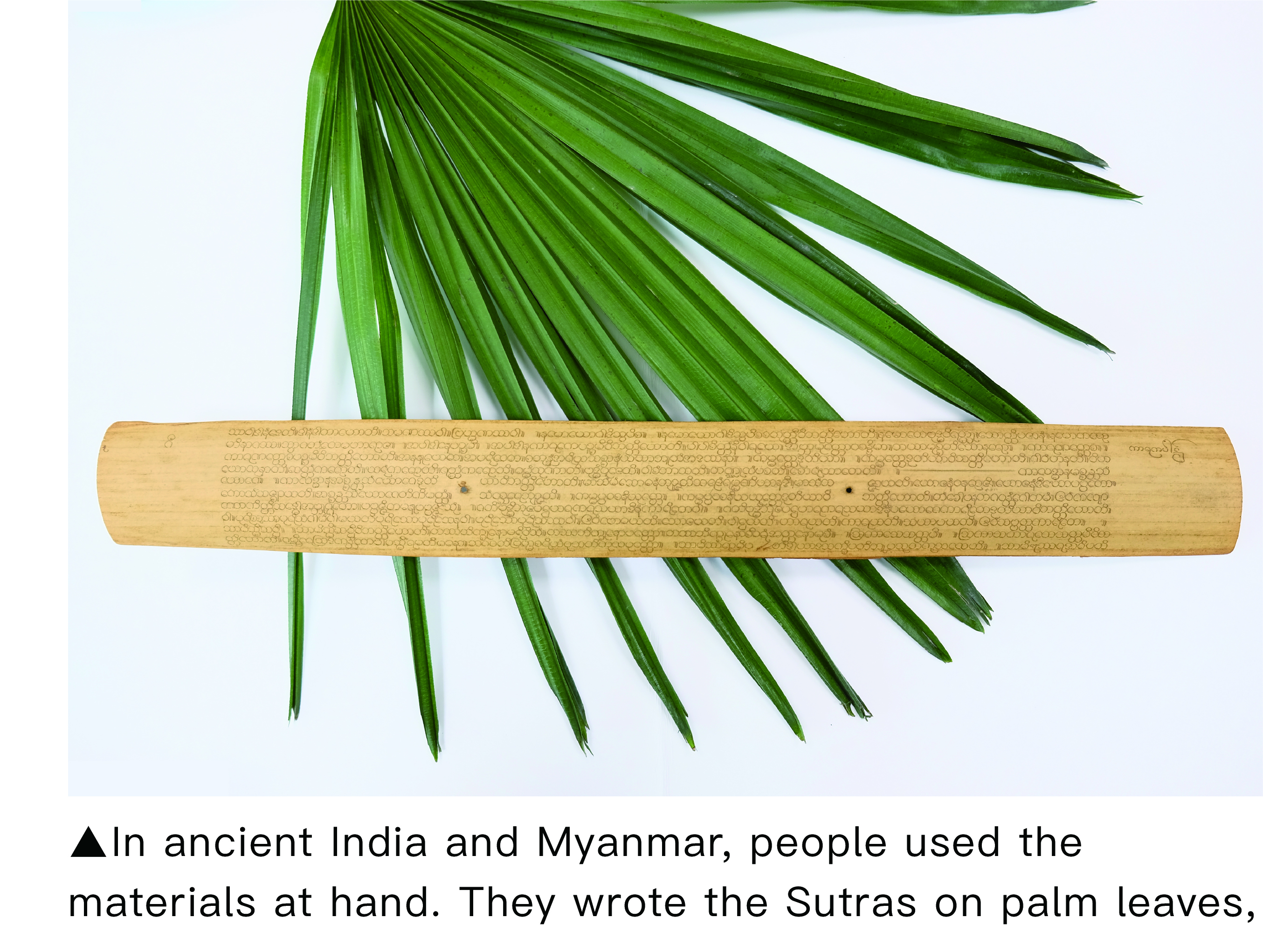 The characters of the ancient Tamil language were very round, composed of circles varying in size - and many people have wondered whether these should in fact be categorized as graffiti or characters. Tamil characters are composed of curvy shapes for a reason. Southern India and Sri Lanka are in the tropics, where the talipot palm trees of the Arecaceae family thrives. In ancient times, locals used the giant leaves as the main materials for writing. To adapt to the horizontal veins of the leaves and prevent carving knives from tearing them, writers developed this unique circular style. Long ago in neighboring Myanmar, characters were likewise written on leaves, resulting in a similar circular style of writing.
The characters of the ancient Tamil language were very round, composed of circles varying in size - and many people have wondered whether these should in fact be categorized as graffiti or characters. Tamil characters are composed of curvy shapes for a reason. Southern India and Sri Lanka are in the tropics, where the talipot palm trees of the Arecaceae family thrives. In ancient times, locals used the giant leaves as the main materials for writing. To adapt to the horizontal veins of the leaves and prevent carving knives from tearing them, writers developed this unique circular style. Long ago in neighboring Myanmar, characters were likewise written on leaves, resulting in a similar circular style of writing.The structure of the Tamil language is deeply influenced by the local climate and environment. Even today, we are able to read from a few ancient religious texts in palm leaf manuscripts that have been adequately preserved. In modern times, some have proposed reforming the Tamil language, but native speakers are deeply proud of the ancient history of their language. They believe that these smooth and round curves - the actual rhythms of writing these characters - exhibit perfect harmony, in such a way that their extreme beauty cannot be arbitrarily altered.
| What is a palm leaf manuscript? Long ago in India and Myanmar, the Sutras were written on palm leaves. Using readily available materials, the people sought to record religious doctrines and promote Buddhism. As Buddhism spread, the making of palm leaf manuscripts was also introduced to other places in Asia. It was actually a palm leaf manuscript that Xuanzang brought to the White Horse Temple during the Tang Dynasty! Along with Myanmar, palm leaf manuscripts in local languages can also be seen in places such as Yunnan province in southwest China. |
Representation of words and phrases in Tamil:
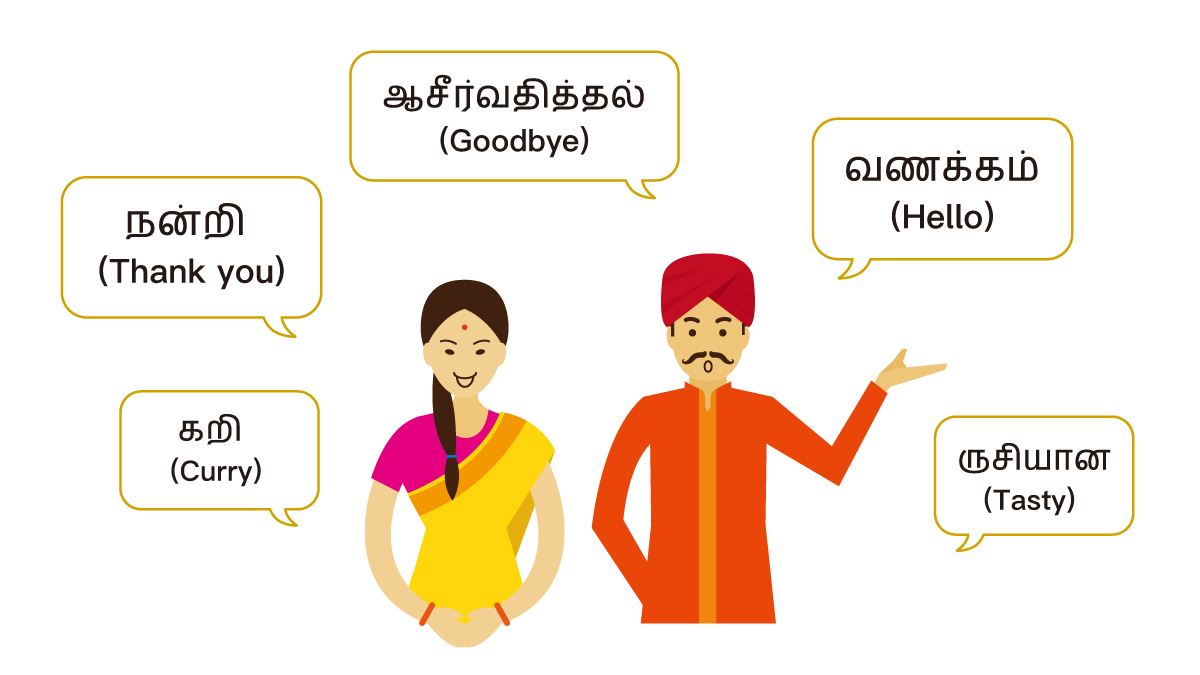
The Tamil people used their sea navigation skills to develop overseas trade early in history. For this reason, the Tamil language has corresponding numbers - including 0-9, 10, 100, and 1000 - and words such as day, month, year, as well as debit and credit.
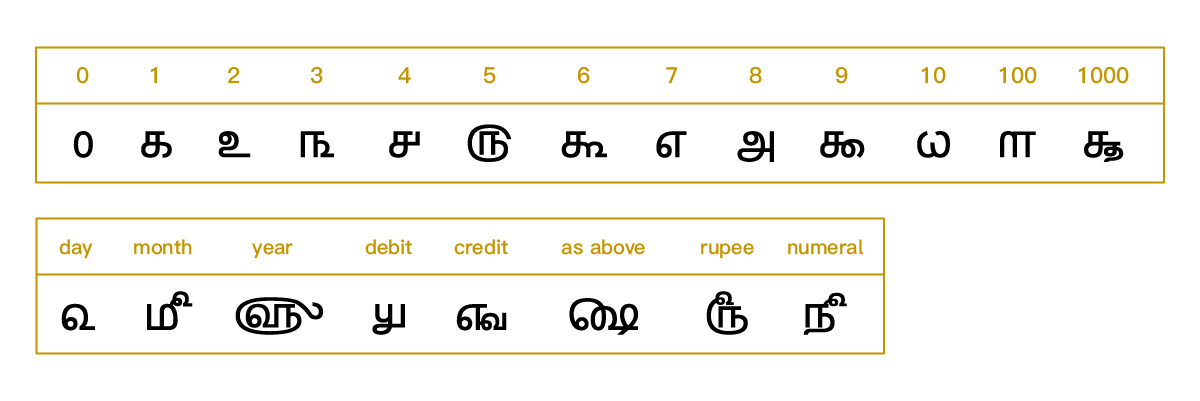
| On reforming the Tamil language In modern times, some have proposed reforming the Tamil language to make it easier to write and learn. However, the language's deep traditions have been an obstacle to any proposed change. Politicians in the government have been reluctant to become involved in this tricky issue, afraid they might be held accountable for violating tradition. It was only in 1979 that the Tamil language was reformed based on Periyar E. V. Ramasamy's proposal - but that was already more than four decades after the first reform proposal. Therefore, it is not hard to imagine how difficult it was to launch such reforms. |
The design concept of DynaFont King Gothic (Tamil language)
After the designer came to understand the long history of Tamil, he placed extra emphasis on the representation of curves in DynaFont King Gothic (Tamil) so the language's profound culture can be showcased, highlighting the beauty of these characters.

The style of DynaFont King Gothic (Tamil) is kept consistent across different languages. Angle and curvatures are all taken into detailed consideration when designing English alphabets and numbers. The distance between characters and sentences are also adjusted based on actual visual effects. The font is well-distributed in width, which makes for smoother reading.
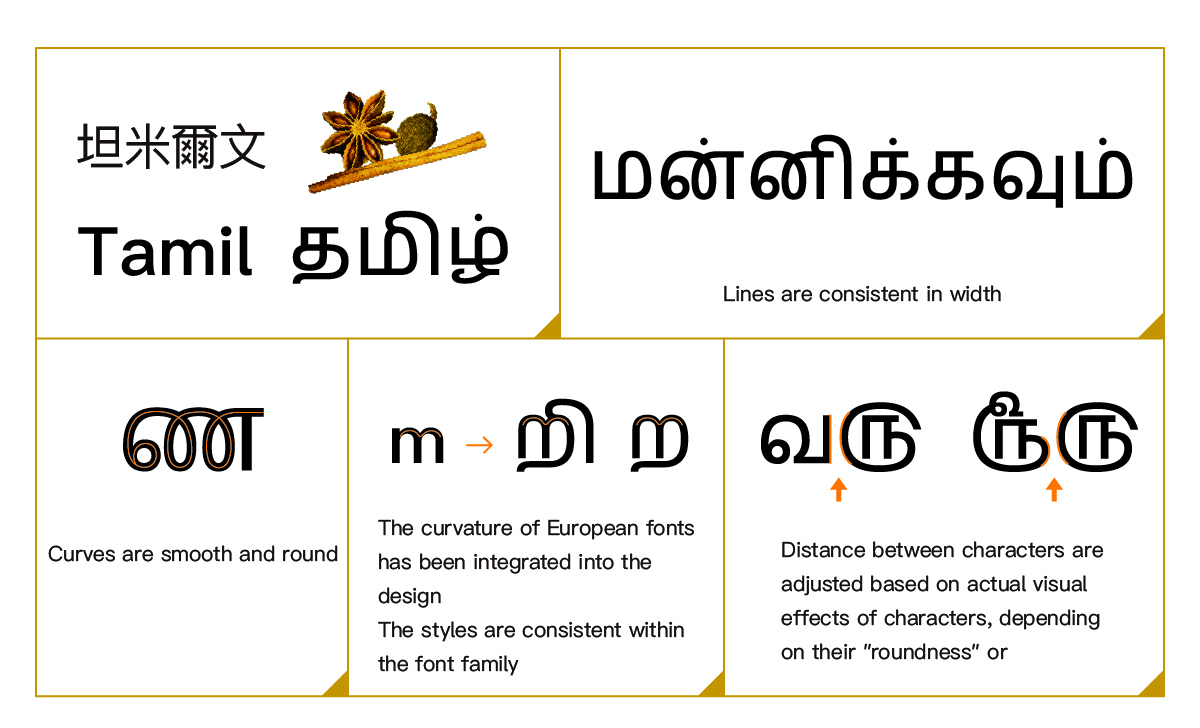
A designer's thoughts on the Tamil language
Q. What is your first impression of the Tamil language?
Designer: Tamil characters are formed with multiple circles, and you can see that they take on a diverse variety of appearances; for example, some characters look like a telephone cord, while others may even look like a hot dog or burger bun. It is a very interesting language.
Q. What are your thoughts on Tamil after designing this font?
Designer: Only after understanding the Tamil language more deeply did I discover that this language has an extremely profound history and culture behind it. People are closely connected with the tradition and are unwilling to simplify the shapes of the characters. Therefore, I was very respectful and cautious throughout the course of designing the font; for example, to ensure that the degrees of curvature turn out perfect, I consulted experts several times!
Q. Did understanding the culture behind the language help with the design?
Designer: The users of the language believe its characters have to be sufficiently round and smooth to be aesthetically beautiful. If the designer is not aware of this consideration, he or she might not be able to understand the perfect harmony stressed by the Tamil people and as a result, may end up designing characters that are more or less lifeless. It would be like us seeing a foreigner writing Chinese - the overall shape is there, but the written text has no life, no spirit!
If you are interested in receiving information about purchasing DynaFont King Gothic (Tamil language) authorization plans, you are welcome to contact our customer service.